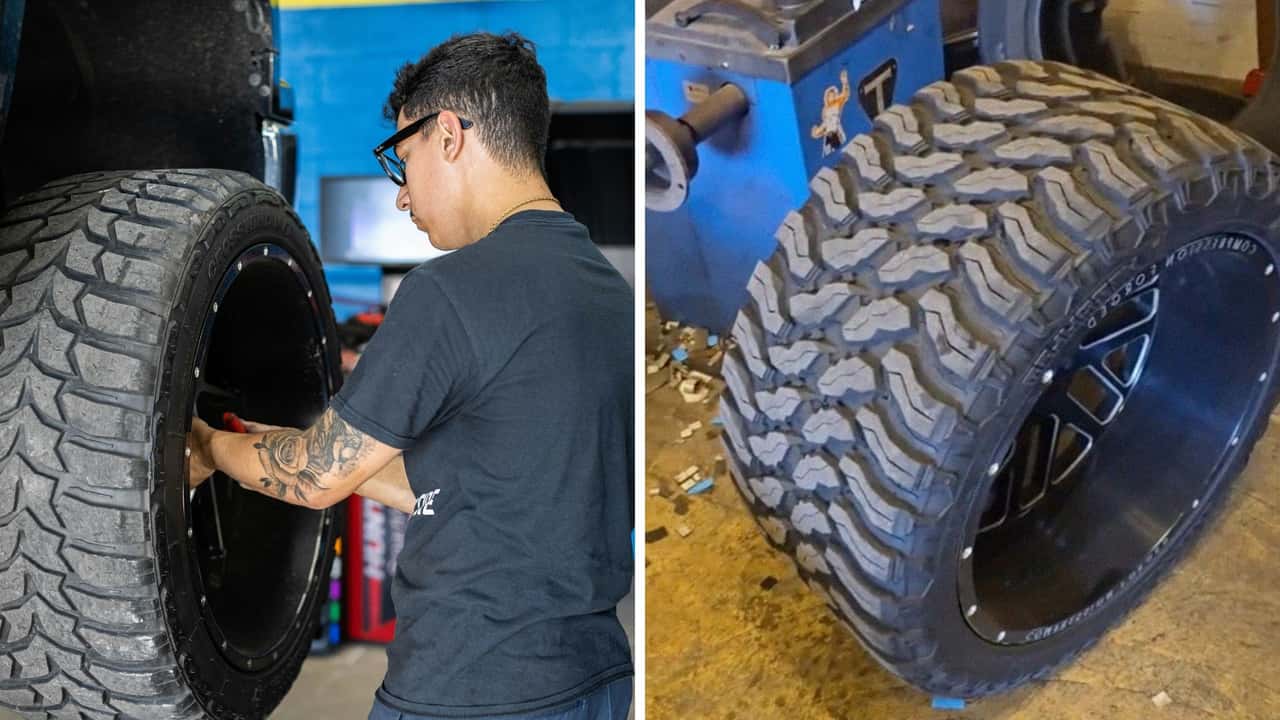“Alarming.”
One of the most misguided wheel balancing jobs ever makes it look like someone attempted to chrome-plate a truck wheel with lead. The result? Laughs, lots of ridicule, and a lofty repair bill.
A viral Facebook Reel with over 1.1 million views shows a tire rim plastered with so many adhesive wheel weights that it practically gleams. The unnamed mechanic pans over the mess while explaining the owner’s complaint: “shaking and bouncing when driving down the road.” By the time creator Walton TV finishes, even veteran techs are laughing and cringing at what they’re seeing.
As funny as the image is, it also serves as a cautionary technical moment: when so many weights are required, it usually means the underlying wheel-and-tire assembly has more than just a simple balance issue. In professional service circles, the rule of thumb is that any single wheel requiring more than a few ounces of corrective weight demands further inspection. On enthusiast forums, one technician wrote that “15 hammer-on weights on one wheel is on the verge of alarming … if wheel weight is exceeding 5 oz there is likely an out-of-round tire or bent rim going on.”
So what is balancing really doing, and why did this wheel end up looking like it had “metal molars” to borrow a popular analogy around its rim?
At its simplest, wheel balancing corrects uneven mass distribution in the tire-and-wheel assembly, allowing it to spin cleanly at speed without transmitting vibrations to the steering, suspension, or chassis. However, traditional spin balancing has its limitations, especially in modern vehicles with oversized wheels or truck setups, because it doesn’t account for how the tire and wheel behave under load or real-world forces. A “road force” balancer, by comparison, simulates the vehicle’s weight pressing on the tire as it spins, allowing the technician to detect stiffness variations, out-of-round wheels, or other structural defects.
What Drivers Are Saying
In the case captured in the viral clip, several red flags are evident. The rim appears extraordinarily large and likely has a negative offset, as well as a wide tire. That’s a common scenario in lifted trucks or over-the-top show builds.
Viral stories from across the web
Our team of experts tracks what owners are saying about car-shopping, repairs, the daily driving experience and more on social media.
These setups are inherently more prone to vibration because the tire sidewalls are shorter and the wheel assembly imposes greater unsprung mass. Many commenters on the video noted this, speculating that the shop may not have had a proper road-force machine and simply added what looked like “a full pound” of stick-ons to counter the vibration.
While the Facebook clip doesn’t mention what it ultimately cost to fix, a wheel in this condition wouldn’t be cheap to set right. If the rim is bent or out of round, professional straightening can cost between $100 and $150 per wheel, depending on the severity of the damage. Replacing an aftermarket alloy rim of that size could easily cost significantly more, not counting the tire itself. Add labor for mounting, balancing, and alignment, and it’s easy for a “simple shake” complaint to turn into a repair costing $1,000 or more.
Even if the wheel isn’t physically damaged, repeated improper balancing can damage the tire’s internal belts or prematurely wear the suspension, leading to additional replacement costs. Vibration left uncorrected can shorten tire life by 20% or more, which serves as proof that ignoring physics can get expensive fast.
The fact that adhesive weights dominate the rim surface suggests the shop was attempting to compensate for more than just a normal imbalance. It could indicate a bent rim, an out-of-round tire, improper bead seating, or a mismatch between tire and rim. And the visual spectacle of dozens of weights lined up like “gold teeth” around the wheel is itself a symptom: physics doesn’t scale easily.
When you mount an oversized mud-terrain tire on a deep-dish show rim without proper engineering, the balancing machine can only mitigate so much. At some point, the fix isn’t weight placement, but going back and correcting the root cause via a properly sized tire.
A technician faced with this predicament would first check the rim for true and run-out, inspect the tire for stiffness variation or manufacturing defects, and consider employing a road-force balance to simulate the vehicle load. In many cases, the tire may need remounting, rotating 180 degrees on the rim—”spin the tire 180 and re-balance” was a frequent comment on the video—or simply replacing the rim-and-tire combo with a more suitable fitment. For large truck/wheel/tire setups, some shops recommend specialized balancing media or electronically controlled systems rather than dozens of small stick-on weights.
Even if you’re not outfitting your rig with 37-inch mud tires and deep-dish rims, the lesson is clear: vibration is a symptom of something going wrong. It can lead to premature tire wear, damage to suspension components, steering problems, and safety risks. For the modified-truck community, the episode is a reminder that styling choices come with mechanical trade-offs. As one commenter aptly summed up: “Big wheels & tires like that are gonna ride like crap no matter how balanced out they are… those things are just for looks.”
At the end of the day, when your rim looks like it has a metallic grin of weights around it, don’t laugh. Take it as a sign that you’re chasing the wrong fix. Balance isn’t about piling on lead or weights, but is about addressing the assembly dynamics. And if you find yourself staring at more than a few ounces of corrective weights, the best move is to stop and assess if the wheel was set up right in the first place.
Motor1 reached out to the creator via direct message and comment on the clip. We’ll be sure to update this if they respond.
More From Motor1
We want your opinion!
What would you like to see on Motor1.com?
– The Motor1.com Team
